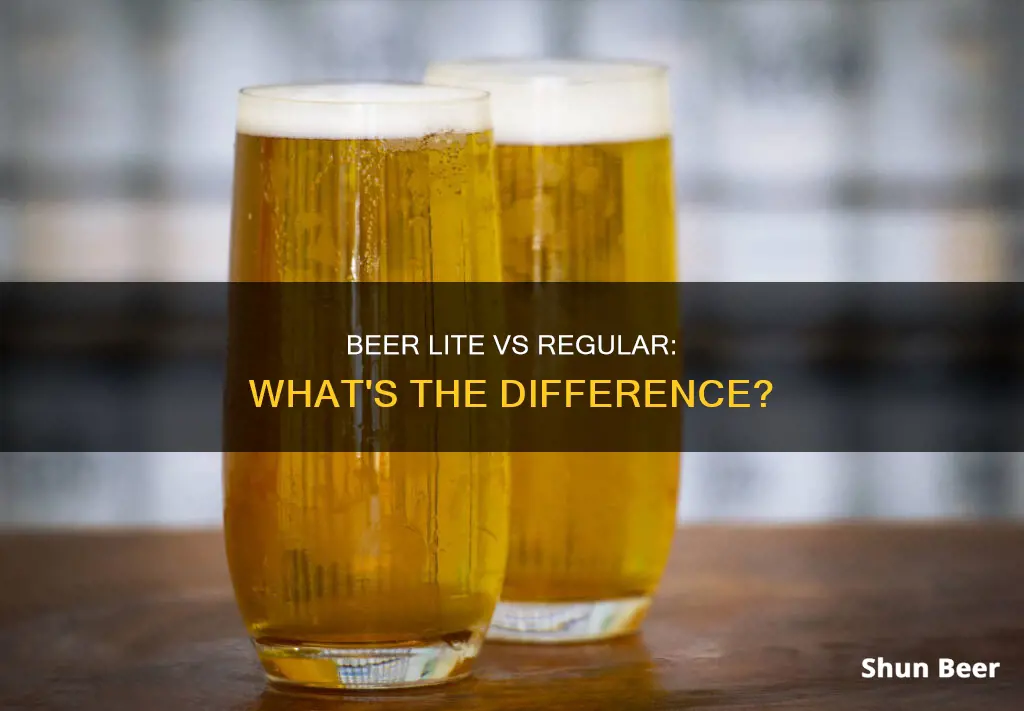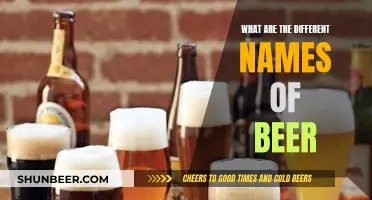
Light beer has fewer calories than regular beer, which leads to a lower alcohol content. The Alcohol and Tobacco Tax and Trade Bureau (TTB) defines a light beer as a beer with a meaningful decrease in calories compared to a full-strength version. Light beers are often seen as inferior because they are watered-down versions of fuller-bodied beers, with a compromise in flavour for fewer calories. However, this perception may be changing as more craft brewing companies are offering light beers. Despite the criticism, light beers remain the most popular pours in the US, with Bud Light, Miller Lite, Coors Light, and Michelob Ultra making up the top four of draft beer sales in 2019.
What You'll Learn

Light beer is lower in calories
The TTB also requires that brewers state the calorie content on the packaging. This is because light beer is often chosen for its lower calorie count. The average regular beer contains 150-153 calories, while a light beer typically has around 100-103 calories.
The lower calorie content of light beers is achieved through a few different methods. One way is to dilute regular beer with water to reduce its calorie and alcohol content. Another method is to decrease the serving size so that the package is small enough to contain fewer calories. A third technique involves extending the mashing process so that the natural enzymes in barley break down more of the carbohydrates into simple sugars. These sugars are then fermented, and the resulting product is diluted with water to create a lighter beer.
Some critics of light beer argue that the lower calorie content comes at the cost of flavour. By reducing calories, brewers may also significantly reduce or eliminate ingredients like hops or yeast, which can lead to a loss of flavour. However, supporters of light beer appreciate its lighter, crisper taste and the fact that it provides a similar drinking experience with fewer calories.
EBC Beer Shipping: State-by-State Availability and Restrictions
You may want to see also

Light beer has less alcohol
The Alcohol and Tobacco Tax and Trade Bureau (TTB) in the US defines a light beer as a beer with significantly fewer calories than a comparable full-calorie beer. The TTB mandates that beers labelled "light" must display the number of calories, fat, carbohydrates, and protein they contain.
There are several methods to produce a light beer with fewer calories. One method is to dilute regular-strength beer with water to achieve the desired alcohol and calorie content. Another method is to decrease the serving size so that the package is small enough to contain fewer calories than a comparable full-strength, full-size serving. For example, a 6-ounce bottle or can may contain 75 calories, compared to 150 calories in a 12-ounce serving.
A third method involves extending the mashing process so that the natural enzymes in barley break down the carbohydrate material into simple sugars. These sugars are then fermented into alcohol and carbon dioxide, and the beer is diluted with water to create a light beer. A fourth method is to introduce exogenous brewing enzymes into the mash or fermenting beer to break down the carbohydrates into simple sugars. The sugars are then fermented, and the beer is diluted with water to produce a light beer.
The perception of light beers may be shifting as more craft brewing companies enter the market and offer alternatives to the mega-brewers' products. However, critics argue that light beers sacrifice flavour for fewer calories, resulting in a beer-flavoured water taste.
Budlight vs Amber Beer: Taste, Color, and Alcohol Content
You may want to see also

Light beers are often watered-down versions
The perception of light beers as watered-down versions is so prevalent that some breweries have tried to change this perception. For example, Jim Koch, the man behind Samuel Adams, wanted to change the perception of light beers as being flavourless. In 2001, his brand introduced a light version of its signature beer, Samuel Adams Boston Lager, called Sam Adams Light. This move was seen as unconventional for a "craft" brewer, and it took two years and 23 test batches to perfect the recipe and brewing process.
The process of creating a light beer with fewer calories is fundamentally the same as making regular beer, but it can be more intricate and complicated. One technique used is decoction mashing, which involves conducting multi-step mashes without adding additional water or heat to the mash tun. This process suppresses enzymes, allowing the malt to be kilned at a higher temperature to kill malt enzymes and reduce the number of fermentable sugars, resulting in lower alcohol content and fewer calories.
While light beers are often perceived as watered-down, it's important to note that they are still technically beer, brewed in a similar manner to regular beer. The key difference is the reduction in calories, which can be achieved through various methods, such as destroying enzymes, diluting with water, or reducing serving sizes.
Draught vs Lager Beer: What's the Real Difference?
You may want to see also

Light beers are harder to produce
The light beer brewing process is more challenging because it requires a great deal of craftsmanship to mask the thin flavour and any defects in the more than 800 chemical compounds within. As a result, light beers are considered a brewer's beer. The process is so precise that every pour from every brewery tastes exactly the same.
One of the key challenges in brewing light beer is achieving a consistent and repeatable flavour profile. Light-style lager beers, in particular, are unforgiving due to their lighter body and more subtle flavour profiles. This makes quality control extremely important. Any trace of wort from the previous brew baked onto the interior of the brew kettle, for example, will change the taste and ruin the drinkability.
Another challenge in brewing light beer is the fermentation process. Light beer relies on a temperamental yeast that needs to be activated, stored, and monitored at precise temperatures to yield the proper flavour. At the Anheuser-Busch Newark Brewery, for example, the lager yeast is stored at 32°F when it's not in use, slowing down the yeast's metabolism to near zero. When the yeast is used, it is given a specific mission and undergoes a precise fermentation process to achieve the desired flavour.
Overall, while the basic process for brewing light beer is the same as for regular beer, the additional challenges of craftsmanship, quality control, and fermentation make it harder to produce a consistent and repeatable product.
Explore the Difference Between Ales and Beers
You may want to see also

Light beers are more popular
Light beers are popular because they are cheaper, easier to drink, and have fewer calories and a lower alcohol content. Light beers are also popular because they are less filling, allowing people to drink more without becoming full. They are also a good option for people who want to manage their alcohol consumption or calorie intake.
The popularity of light beers can also be attributed to historical factors. Prohibition destroyed local brewing cultures across the US, and only the large lager breweries were able to stay open. When brewing was legalised again, the number of breweries dropped from around 2,000 to less than 100. As a result, the large breweries gained more market share, mainly selling American pale lager.
In the 1970s, with the rise of public consciousness about healthy eating, demand grew for a beer that was lower in calories. This, combined with a destitute beer culture that viewed beer as just for easy, simple, thirst-quenching drinking, led to the triumph of light beer in the 80s and 90s.
The popularity of light beers can also be explained by the fact that they are less complex in flavour and have a lighter body and more subtle flavour profiles. Craft beers, on the other hand, tend to have stronger flavours which many people don't like. Light beers taste like water, and everyone likes water.
Beer, Ale, Lager, Stout: What Sets Them Apart?
You may want to see also
Frequently asked questions
Lite beer, or light beer, is a beer that is reduced in alcohol content or calories compared to regular beers. Light beers are usually chosen by those who want to manage their alcohol or calorie consumption but are sometimes criticised for being less flavourful than full-strength beers.
There are a few methods to make light beer. One process, used by brewers like Sam Adams, involves destroying enzymes during the brewing process to lower the amount of fermentable sugars, which in turn lowers the ABV and calories. Another method is to dilute regular beer with water, or to reduce the serving size.
Light beers cut the average 153 calories in a 12-ounce regular beer to around 103 calories. They also tend to have more than half the carbs of regular beer. However, some reports suggest that drinkers of light beer tend to consume more beers overall, potentially cancelling out the health benefits.
Some people claim that light beers are less flavourful than regular beers, tasting like watered-down versions of their full-strength counterparts. Others argue that light beers are overpriced and that the lower ABV means you have to drink more to feel the effects, resulting in increased trips to the bathroom.







